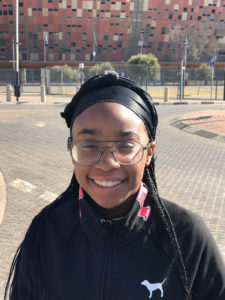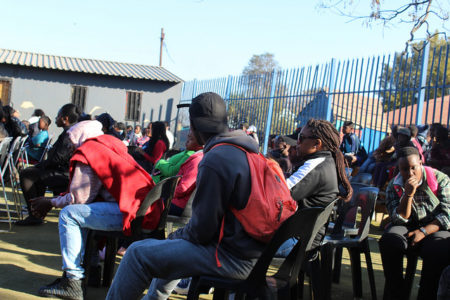 Monday, July 2 – Today is the day that we entered Langa, and we met our tour guide, Mike Zuma. We had been brought to Guga Sithebe, which is a community center that was built in 1999. This center was a built to create a space for arts and culture. Going through, the tour guide explained that the building has been constructed using recycled materials like the outside theater. This theater was made out of shipping containers as well as eco-brick. Eco-brick is made out of plastic bottles that are compacted with trash to create a hard, tight “brick” to build with.
Monday, July 2 – Today is the day that we entered Langa, and we met our tour guide, Mike Zuma. We had been brought to Guga Sithebe, which is a community center that was built in 1999. This center was a built to create a space for arts and culture. Going through, the tour guide explained that the building has been constructed using recycled materials like the outside theater. This theater was made out of shipping containers as well as eco-brick. Eco-brick is made out of plastic bottles that are compacted with trash to create a hard, tight “brick” to build with.
Going further into the afternoon, we entered Dompas Museum and it was like another puzzle piece to understand the effects of apartheid. The days before we had pieces of information, but the museum helped tie things together such as the Sharpeville Massacre, which happened on the 21st of March, 1960. In the beginning, I didn’t think making a museum based on this was necessary, but then I realized little things like that have created a big impact on the South African society.
Later into the evening, we drove down the street and learned about a white activist working against apartheid in the black townships, and we learned it was about more than just the color of one’s skin. One night Amy was walking home and was attacked, stoned, and beaten by a group of black men based on the color of her skin. These men were not aware of Amy’s work inside of the black townships, but all they saw in that moment was the color of her skin. Further down the road we saw the memorial of the Gugulethu Seven. These were a group of young black men who were activists in the township. In the early morning of March 3rd in 1986 the seven activists were ambushed by South African Police and were shot dead. The two officers that were involved had the suspicion that the men were going to attack a police van.
 Today was full of information that hit home and created a tie between my community and the community here in South Africa. I have been able to sit back and realize that assumptions can impact decisions. If you can think then you can decide. In my community the thoughts that come to mind can trigger the actions of violence and discrimination. For example white police officers easily use their suspicions or assumptions to shoot or to incriminate a black person. Here in South Africa, it goes the same exact way. White individuals have their own assumptions of black South Africans, and they have acted on those thoughts for years. We are thousands of miles away and yet not that different.
Today was full of information that hit home and created a tie between my community and the community here in South Africa. I have been able to sit back and realize that assumptions can impact decisions. If you can think then you can decide. In my community the thoughts that come to mind can trigger the actions of violence and discrimination. For example white police officers easily use their suspicions or assumptions to shoot or to incriminate a black person. Here in South Africa, it goes the same exact way. White individuals have their own assumptions of black South Africans, and they have acted on those thoughts for years. We are thousands of miles away and yet not that different.
Thelanie R., Northwood High School
